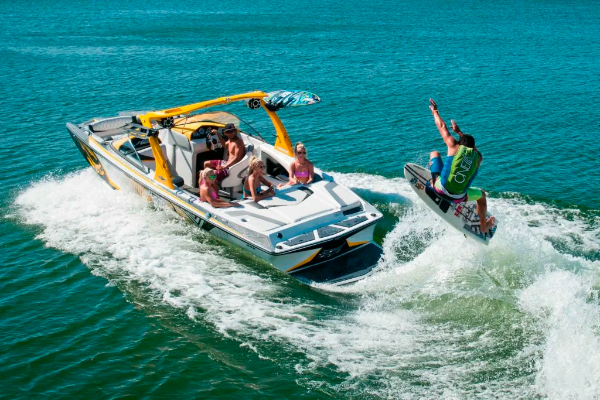Docking a wakeboard boat can be challenging, especially for beginners. Proper docking ensures the safety of the boat, passengers, and the dock itself. Mastering this skill enhances your overall boating experience and prevents potential damage. This article provides a detailed guide on how to dock a wakeboard boat, covering all essential aspects from preparation to execution. By following these steps and practicing regularly, you’ll become proficient in docking, even under challenging conditions.
Preparation Before Docking
Check Weather Conditions
Before you begin the docking process, it’s crucial to check the weather conditions. High winds, strong currents, or poor visibility can complicate docking. Use reliable weather apps or marine forecasts to stay informed. If conditions are unfavorable, consider waiting until they improve.
Assess the Dock and Surroundings
Examine the dock where you plan to dock your boat. Look for obstacles, other boats, and available space. Understanding the layout helps you plan your approach and avoid collisions. Note the location of cleats, pilings, and any other fixtures you’ll use to secure your boat.
Prepare Your Equipment
Ensure all necessary equipment is ready and in good condition. This includes dock lines, fenders, and boat hooks. Place fenders along the side of the boat to protect it from bumps and scrapes during docking. Keep dock lines easily accessible for quick deployment.
Communicate with Your Crew
Clear communication with your crew is essential. Assign specific tasks to each crew member and ensure they understand their roles. Use hand signals or verbal commands to guide each other during the docking process. This coordination minimizes confusion and enhances safety.
See Also: How to Properly Paddle Board
Approaching the Dock
Slow Down and Plan Your Approach
Approach the dock slowly to maintain control of your boat. Planning your approach well in advance allows you to make necessary adjustments. Reduce speed to idle as you get closer, giving you more time to react to any changes in conditions.
Understand the Wind and Current Effects
Wind and current can significantly impact your docking maneuver. Assess their direction and strength before making your approach. Use these forces to your advantage, guiding your boat smoothly towards the dock. If the wind or current is strong, approach the dock from the upwind or up-current side.
Use Appropriate Signals
Use clear and consistent signals to communicate with your crew and other boaters. Hand signals are particularly useful when verbal communication is difficult. Ensure everyone understands the signals and their meanings before starting the docking process.
Maneuvering Towards the Dock
Aligning the Boat with the Dock
Position your boat parallel to the dock as you approach. This alignment makes it easier to move alongside the dock and secure your boat. Adjust your steering gradually to maintain this alignment, using short and controlled movements.
Using Throttle and Steering Controls
Use your throttle and steering controls smoothly to avoid sudden movements. Small adjustments are more effective than large, abrupt changes. Practice using both forward and reverse gears to fine-tune your position as you approach the dock.
Correcting Course for Wind and Current
If wind or current begins to push your boat off course, make gentle corrections. Use the steering wheel or throttle to counteract these forces. It’s better to make multiple small adjustments rather than one large one, which can lead to overcorrection.
Securing the Boat to the Dock
Using Dock Lines and Fenders
Position fenders between your boat and the dock to prevent damage. Attach dock lines to cleats on the boat and dock, ensuring they are secure. Use bow, stern, and spring lines to hold your boat in place and prevent movement.
Tying Knots and Securing Lines
Learn and practice basic knots like the cleat hitch and bowline. These knots are essential for securing dock lines quickly and securely. Ensure lines are tight but not overly strained, allowing some flexibility for water movement.
Adjusting for Tides and Water Levels
If you’re docking in tidal areas, account for changing water levels. Leave some slack in your lines to accommodate rising or falling tides. Regularly check and adjust lines as needed to maintain a secure hold on the dock.
Safety Tips and Best Practices
Maintain Clear Communication
Keep lines of communication open with your crew at all times. Use hand signals or verbal commands to ensure everyone knows what’s happening. Clear communication reduces the risk of accidents and makes the docking process smoother.
Use Proper Docking Equipment
Ensure all docking equipment is in good condition and readily accessible. Regularly inspect fenders, dock lines, and cleats for wear and tear. Replace any damaged equipment to maintain safety and effectiveness.
Stay Calm and Patient
Docking requires patience and composure. Stay calm, even if things don’t go as planned. Panicking can lead to mistakes and accidents. Take your time, make careful adjustments, and trust your skills and preparation.
Common Challenges and Solutions
Dealing with Strong Winds
Strong winds can push your boat off course. Approach the dock from the upwind side to use the wind to your advantage. Use short bursts of throttle to maintain control and make small steering adjustments to stay on track.
Handling Crowded Docks
Crowded docks require extra caution and precision. Plan your approach carefully, and be prepared to wait for an opening. Communicate with other boaters and dock attendants to coordinate your docking maneuver.
Managing Low Visibility Conditions
Low visibility, such as fog or nighttime, adds complexity to docking. Use navigational aids like lights and radar to guide your approach. Slow down and proceed with extra caution, relying on your crew to help spot obstacles.
Conclusion
Docking a wakeboard boat involves careful planning, clear communication, and precise maneuvering. By following these steps and practicing regularly, you’ll gain confidence and proficiency in docking, even under challenging conditions. Remember to stay calm, use proper equipment, and communicate effectively with your crew. Happy boating!

